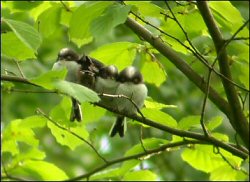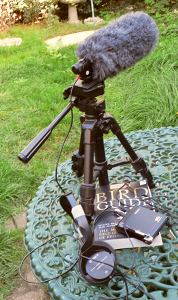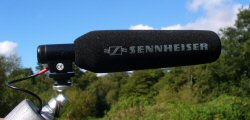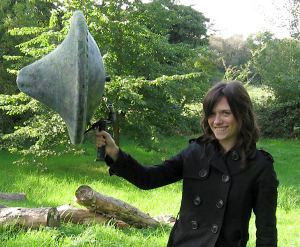
listen to a group of Long-Tailed Tits feeding recorded using equipment described.
Getting started in wildlife sound recording[1]
The newcomer to wildlife sound recording has a bewildering choice of a wide variety of sound recording equipment, designed for a whole range of applications from recording voice notes to recording orchestras. The obvious question he will ask is "what is the cheapest equipment to make wildlife sound recordings". This is what I have tried to make sense of here. Obviously what you will use depends on your budget, subjects and expectations. I have listed some microphones at the low cost end of the price range, and combining these with a card recorder will get you a very good start.
Because most people starting out with wildlife sound recording are interested in recording birds, and generally want to record them from where they view them, this is written from that standpoint. You can get good results that way, and many fine bird recordings have been made from this perspective. As you develop your skills you will discover that there are many advantages to putting your microphones closer to the subjects and further away from you. Nevertheless, most people start from wanting to hold the mic and point it at the bird, so let's take a look at what you need to record wildlife sounds in that way. Some recordings using this approach show the results you may get.
Having the right gear is part of the story. You need to be in the field with it when your subjects are vocal. UK readers can see a summary of the periods when some common British animals are vocal - this naturally coincides with the breeding season and is concentrated around spring and early Summer.
I have pitched this at the amateur recordist in temperate latitudes, for whom cost is usually a greater issue than others, such a time and ruggedness. If you will be recording wildlife in a professional capacity you normally have a larger budget, your time is more expensive, and dare I say it, you will tend be harder on your gear than non-professionals. You will get a better return on your time and resources using products found in higher price ranges. The WSRS booklet cited in the conclusion has more details, and quite a few WSRS members record in a professional capacity so joining the Society will put you in touch with some experienced professional users. If you will be recording in tropical, humid or rainforest regions or in sub-zero temperatures you will also have different equipment needs.

A basic sound recording kit is quite small
the basics
Let me start with the basics - what are the items you really need to record wildlife sounds? At the very minimum, you need a microphone, which turns sound into some sort of electrical signal, and you need a recorder, something to capture this signal and store it. It always pays to be able to listen to what you are recording at the time you are recording it, so you also need a set of headphones.
Most sound recording equipment is designed either for recording music, or it is designed to record the spoken voice from a fairly close range. Neither of these applications are typical of wildlife sound sources. Few creatures can produce the loudness of a garage band or an orchestra and few are as co-operative as a politician pushing a point to a journalist. It takes great skill and patience to get as close to a bird as you would to a human speaker, without creating disturbance.
This means the wildlife sound recordist often has to deal with a much weaker sound source than most microphones and recorders are designed for. He is much further from that source than usual. To add to the challenge, he generally has to go to the subject in the great outdoors, so there is wind to contend with, unwanted background noise, and perhaps extremes of temperature and humidity. These requirements mean that a lot of excellent equipment which gives outstanding results with music in a studio or auditorium is simply not suited to recording natural sounds outdoors.
Speech has lower requirements for recording quality than music, and in practice you can ignore any recording equipment designed to primarily record speech. This includes microcassette recorders, dictaphones, digital voice recorders and the like. You can listen to what effect using this kind of gear has on your results on this test.
You are left with equipment designed for recording music. In any signal processing chain, quality once lost can never be regained, and the microphone is your first point of contact with your sound source. If it doesn't perform right than even a perfect recorder can not do anything to help your results, so I will start at the beginning of the chain.
the microphone
You would like your microphone to reproduce the entire range of frequencies your source can make (and you can hear!) Few birds make particularly low frequency sounds, rarely below middle C (261Hz) and the good news is that even the cheapest microphones on the market will perform satisfactorily in this regard for entry level recording.
Your microphone should not add too much noise of its own. This requirement is often the hardest to satisfy at a budget, because most music recording applications deal with louder sounds so outstandingly low noise is not at a premium. You can compensate for imperfections in this area by getting closer to the source or using a parabolic reflector.
You would like your microphone to pick up sounds in front of it much more than the side and behind. You want it to 'focus on' sounds in front at the expense of other sounds. At first this may sound strange - after all you hear sounds reasonably equally from all around. Surely your microphone should do the same? In practice you will get far better results as a beginner if you can focus on the sound source. After all, to watch birds many people use binoculars to focus on that birds to the exclusion of the rest of the field of view. If your microphone does the same, then background noise which doesn't come from the bird's direction will be quieter in your recording than the sound of the bird. Since the bird is usually a small sound source relative to everything else around the recordist, you want a microphone that is very directional. There are two types of microphone that commonly fit these requirement, the shotgun microphone and the parabolic dish microphone. The principles are described below, and on the next page I describe some cheaper models that you can use.
Shotgun microphone (a.k.a hypercardioid)

shotgun mic
Much longer than a normal microphone, the shotgun mic uses a long tube with holes in calculated positions to cancel out sounds coming from the sides. They are quite sensitive to wind and handling noise, so in Britain you generally need some sort of wind protection, which has the advantage of making this look a bit less like the barrel of a shotgun to other people!
Shotgun microphones are reasonably compact, compared with the parabolic dish, and preserve the tonal balance of what you are recording well. However, because they work by cancelling out sound from unwanted directions rather than collecting sound from a wider area and focusing that on the mic, a shotgun microphone needs to be of a high quality to give low-noise preformance in many nature recording situations. You will need to be a bit closer to your subjects to get good results than with a dish but the tone colour of your recording may then be closer to what you hear. I have listed some lower cost shotgun microphones here
Parabolic dish microphone

parabolic dish microphone
This collects sound from a larger area and focuses it on the microphone, making the mic very directional, in the same way as the reflector on a torch makes the light shine mainly to the front. Because it collects sound from a larger area it delivers more sound to the microphone, giving a noise-free boost in sound level and unparalleled sensitivity. Some designs are also less sensitive to wind noise.
This performance is bought at a cost - a parabola has to be large to pick up low frequencies so it needs to be about 50cm in diameter for most uses, and it distorts the tonal balance of the system, emphasising high frequencies at the expense of low ones. The dish adds some weight, and dragging something that large through the undergrowth or holding it steady in the wind can be fatiguing in the field. This can be overcome, either by using a monopod or a tripod. Despite the problems, if you are at a long range (more than 20m) from a quiet source, if a parabolic reflector cannot give you a strong enough signal to record, nothing else will.
Beware the sort of cheap toy sold on ebay as a "spy listening device" which have a small parabolic dish and inbuilt amplifier. The parabola on these is usually too small to be particularly effective for wildlife sound recording.
If you are technically minded, construction of a parabolic dish does offer a lot
of room to get a good performance for a low cost. In particular the noiseless gain
means you get both a higher signal level and the noise of your microphone impacts the recording
of soft sounds less.
the recorder
this will be a digital recorder of some kind, and at a budget the best choice at the time of writing is a SD or CF card recorder. Cheap recorders tend to be weak in terms of noise and the amount of gain available, so they will give you hissy recordings with low noise microphones. At the stage of a beginner your microphones are probably noisier than the cheap recorder, but the recorder will prevent you realising the improvement mid-quality or good quality mics can offer to the noise level. And noise is usually one of the first things a beginner finds fault with in his recordings. Read more about recorder options here
fieldcraft
Getting good recordings is also a matter of knowing your creature and how and when to approach it. Your sound quality improves as you get closer to the sound source, and the demands on your equipment get less as you do this because the sound becomes louder, both in absolute terms and also relative to the sound source.
next - Microphones- This article was originally written for the Wildlife Sound Recording Society WSRS in 2006 on the URL http://www.wildlife-sound.org/equipment/newcomersguide/index.html The WSRS have a more concise newcomer's guide now. I have updated the content of this for 2017